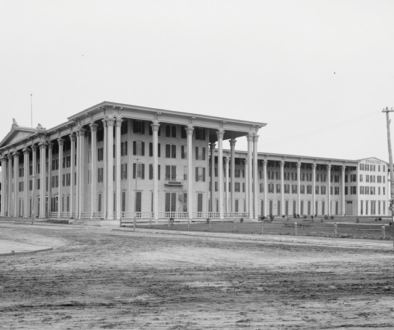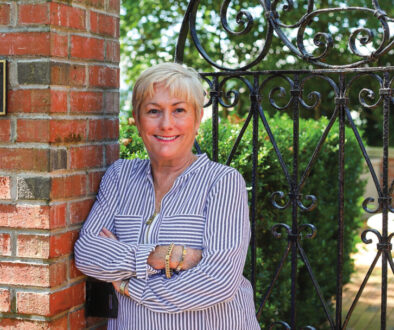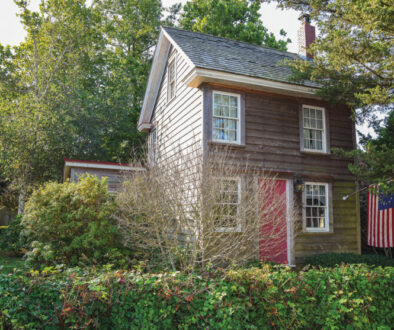Into the Wild
Finding Yourself in Cape May’s Nature Preserves
“Wilderness is not a luxury but a necessity of the human spirit, and as vital to our lives as water and good bread. A civilization which destroys what little remains of the wild, the spare, the original, is cutting itself off from its origins and betraying the principle of civilization itself.”
It may seem a bit hyperbolic to introduce an article about Cape May’s nature preserves with Edward Abbey’s ruminations about nature undertaken during a rafting adventure down the Colorado River with his buddy. In “Down the River,” a chapter from Abbey’s seminal 1968 book Desert Solitaire: A Season in the Wilderness, he reflects on the experience of exploring Glen Canyon, which he characterized as “an Eden, a portion of the earth’s original paradise” before it was flooded to create the Lake Powell reservoir in 1963.
Abbey’s expedition takes place on a grander scale than a visit to the Garrett Family Preserve, just a few minutes from downtown Cape May, and grander than a stroll along the eroding macadam paths through the former Ponderlodge Golf Club, now known as Cox Hall Creek Wildlife Management Area in Villas. But the sentiment remains the same.
Through very different paths, both Garret and Cox Hall Creek WMA are preserved forever, and offer an unexpected quiet respite and immersive nature experience as a break from the beach and the town.
Garrett Family Preserve at Cape Island Creek
801 Wilson Street (off Seashore Road)
James Garrett was a retired schoolteacher in Philadelphia and lifelong supporter of The Nature Conservancy (TNC), and when he died in 2010, he included TNC in his will. His family had a request: Use the bequest somewhere in Cape May to honor all the time they spent here together when they were growing up. Together with TNC staff, they found with the perfect location in the Cape Island Creek Nature Preserve, located just across the creek from the cottage where Garrett and his family spent so many of their summers.



Before TNC acquired the property in 2000, it was primarily used for agriculture. When a developer came in with a plan to build 24 units of a subdivision called “Egret Walk” in 1999, TNC swooped in and established the Cape Island Creek Preserve.
Some of the Garrett gift was used to purchase six additional acres of land in 2012 to make a buffer, while other funds helped create a parking lot, a kiosk, a bird blind, and a shaded picnic pavilion. TNC planted over four acres of wildflowers and installed a four-mile trail system. “Today, the area is chock full of butterflies,” says Damon Noe, Critical Lands Manager for The Nature Conservancy. “The area provides critical habitat for birds, but it is also a wonderful resource for insects.”
Noe notes that three quarters of everything we eat is pollinated by insects such as wasps, butterflies, and bees. “There’s no way around it. If all insects disappeared, a month or two later and we’d all be gone, too,” he says. Accordingly, the trail features an “insect hotel” which is housed in a seven by four-foot dresser. One side is full of pine cones, the other with wood, and visitors can see the insects working.
Noe manages all of TNC’s flagship preserves, which are the ones that receive more resources and are open to the public. “I’ll make sure they have benches, a nice trail system,” he explains. He also is responsible for building parking lots, and for the day-to-day management of the particular species in those areas. “One day, I’ll be doing something super science-y and cool, and another day, I’ll be in the parking lot picking up trash.”


Before the Garrett family’s gift, the preserve wasn’t a particularly welcoming place for visitors. “There were no established trails, and no signage,” Noe recalls. “Although 99.9% of what we own is open to the public, many people don’t want to just wander through the woods, so visitors were mostly die-hard birders and locals. It turned the area from a minimally visited generic spot to a beautiful destination spot. This place is important, because it’s a quiet open space to decompress and wind down. It’s new, it’s by itself, and you can get away from the hustle and bustle.”
One of Garrett’s unique features is the collection of artists’ easels mounted in the preserve. “I had this idea that Cape May is an artsy place,” he says. “So we installed adjustable, permanent easels that swivel on a bearing. Artists can set up and paint something, and then spin around and paint something else.” One day, he hopes to host an artists’ day at Garrett.
The philosophy of nature photographer Ansel Adams echoes Noe’s vision, positing that the production of art is critical in raising awareness of the value of these irreplaceable wilderness spaces. In his essay “The Meaning of the National Parks,” first published in My Camera in the National Parks in 1950, Adams writes that, “The great wilderness areas, designated for perpetuation of the intangible qualities of Nature, must be given appropriate use and interpretation, and complete protection. Perhaps one of the most positive ways of achieving this objective is to encourage writers, artists, and photographers to utilize these profoundly beautiful areas as sources of inspiration and interpretation to the fullest possible extent. It is necessary to penetrate the illusion of mere ‘scenery’ to achieve a more profound understanding of the world about us.”
Protection is part of preservation, and The Nature Conservancy wields a formidable amount of power on that front. “We are the largest conservation organization on the planet. We’ve been able to effect positive change in all 50 states and in 72 countries across the planet,” proclaims Noe. “We have 400 scientists working to solve the issues that confront us. I like to think that we are the engineers and masons trying to rebuild the foundation, not sticking a finger in the dam.”
“Let’s say a 10,000-acre piece of land comes up, with all sorts of red tape involved,” he continues. “The next day, TNC can call up and say ‘We’ll take it.’” Indeed, TNC has preserved some of this area’s most iconic resources, including Higbee Beach and Cape May Point State Park.
South Cape May Meadows is another area preserved by TNC, one that shares an intriguing connection to Garrett. “If you look at a map, the eastern edge of Garrett preserve is a giant salt marsh, which is Cape Island Creek,” he says. “If you go away from the ocean and follow the creek, it disappears under Cape May and reappears in Cape May Meadows.”
The Meadows is a world-class birding area, hosting more than 250 species, and on any given day, Noe says you can see beach nesting birds like the American oyster catcher, black skimmer, and the piping plover. “Fall and spring migration are insane.” During nesting season, visitors are forbidden to sunbathe or lie on the mile of protected beach. “You’ll look, and there is this massive beautiful empty beach in the middle of the busy season,” he says.
Noe encourages visitors to use the power of social media to support spaces like Garrett. “If you come and visit, post it on social media. Do reviews on Google. Come check it out and spread the word. Call the Conservancy and tell them you had a good time. That’s how, in turn, we’re able to ask for more support.”
Cox Hall Creek Wildlife Management Area
5 Shawmont Avenue, Villas (off Bayshore Road)
Tucked away not far from North Cape May’s beach on the Delaware Bay is Cox Hall Creek Wildlife Management Area (WMA). I happened upon this unexpected swath of wooded respite last year during an afternoon spent exploring the back roads of North Cape May and the Villas on my bike. No one was around, and encroaching storm clouds cast ominous shadows on the crumbling, overgrown asphalt paths. Not knowing where I was or what I had found, I pedaled through grassy fields until I found a lake—of sorts. It was delightfully spooky, and just when I convinced myself to turn around, lest I disappear forever into this mysterious, uncharted wilderness, a white-haired woman in a blouse and khaki shorts came ambling around the corner with two tiny dogs in tow.


Cox Hall Creek WMA started out as the Ponderlodge Golf Course, which explains those macadam pathways. It was owned by the Pflaumer family, who also owned Schmidt’s Brewery in Philadelphia from 1976 to 1987. They used the property as a corporate retreat for people to golf, complete with hotel and banquet rooms. Over time, they opened it to the public, but eventually, it came up for bankruptcy sale in 2004, years after the brewery had closed.
At a subsequent planning meeting, a proposal was submitted for a 400-unit subdivision, which is when David Golden got involved. Golden has served as Director of New Jersey Fish and Wildlife since spring 2019. A biologist by training, he started with the division in 2001 as a herpetologist, studying the reptiles and amphibians of South Jersey, and later shifting his focus to invertebrates and insects.
Sensing the property’s potential to offer something special as a wildlife area, Golden appealed to Green Acres, a program offered by the New Jersey Department of Environmental Protection that facilitates land acquisition, who stepped in and purchased the land, saving it from development. Together with another member, he worked on developing management plans as well as habitat restoration and trail design.


“Because it was a golf course, numerous macadam paths already lined the property,” he explains, “and so they were connected and some sections removed to create a usable loop trail system.”
For habitat, they developed a logical approach to maintain the fields and forests as they move through their natural succession process. “We deliberately made the middle of the property forested,” he shares. “On the south end, the forest isolates it from the housing development there, to make it feel more isolated.”
One of his favorite trails extends from the east through woods filled with large trees. It’s not far from his home, so he usually runs it two to three days a week. There are others, like the east-west stretch on the south side of the site. “You turn toward this long vista of fields and it’s a cool scene.” And then there is the lake. “There is some unusual topography there. If you go around the lake, there are some small hills and rises that the trail takes you along, which is different than this area of New Jersey that is usually flat,” he says.


Golden enjoys the surprisingly diverse habitats that are present at Cox Hall. “You can walk through woods, you can walk through old fields. There’s a lake and other wetland sites. With a mix of manicured and macadam trails, you feel like you’re deep in there, yet you’re on a paved trail. In an area surrounded on three sides by coastal habitat, here is this 300-acre upland habitat right in the middle.”
Wildlife is a major draw. “You’ll see deer. There are river otters in the lake, as well as really large turtles that bask on the island and structures in the lake. There are snakes that bask along the trail.” (Golden makes sure to mention that there are no venomous snakes in this part of New Jersey.)
Cox Hall Creek is also a destination for anglers. “We stock trout in the large pond,” he says. “We started stocking the pond 10 years ago, and today, this is one of only two sites in Cape May County where trout is stocked.” Catfish and large mouth bass are also found in the pond. (Note: Licenses are required for anyone over 16 and may be purchased at njfishandwildlife.com.)
Golden cites a nationwide effort to take better care of pollinators, a movement mirrored in Cox Hall Creek’s practices. “Our management on the field has focused on pollinators,” he says. “When managing fields, we do it with pollinator-style mix. Bee balm, butterfly bush, black-eyed Susan, and partridge pea are popular choices, as are sunflowers, which serve pollinators when they bloom and also birds when they go to seed.”
New Jersey Fish and Wildlife oversees a wildlife management system encompassing 354,000 acres, with 122 wildlife management areas. A little-known fact about the division is that it is not funded by the taxpayer. “Our business model is different from New Jersey Parks, which receives state tax money,” Golden says. “Our budget comes from license revenues and grants, so buying a fishing license and going fishing at Cox Hall Creek is actually the most effective way to support our organization.”
Open space doesn’t always prevail. Right now, there is a seven-acre parcel of land north of Cox Hall Creek’s parking lot slated for development, approved for 20 houses through a zoning variance by Lower Township.
Golden is practical about the implications. “You’ll just have to go further south to get that isolated feeling. Now, folks will see a 20-unit subdivision rather than that open space they thought was a part of Cox Hall Creek.”
A Different Kind of Visitor
These preserves offer respite to visitors other than just the ones who sunbathe on the beach and frequent the bars and restaurants; they are essential to migratory wildlife.
The Cape May area is located along what’s called the Atlantic Flyway. “Throughout the northeast and Canada in the spring and summer, birds, bats, and butterflies are reproducing,” Golden explains. “Come autumn, the adults and the new offspring pick up and fly south. The prevailing winds come from the west. They come up against the coast and see the ocean, and know they can’t go any further, so they hug the coast, and eventually get funneled into Cape May.”
All of these winged creatures, which are expending tremendous amounts of energy on their flights, see the 12-mile expanse of the Delaware Bay looming ahead, and know they need to fuel up before they undertake the journey. Cape May is ideally situated for a refueling station, which leads to such a high concentration of birds in the fall.
Damon Noe continues. “These birds have to refuel, and the best things they can eat are fruits and berries rich in high-lipid fats, which give them longer-term energy. At Garrett, we planted hundreds and hundreds of these kinds of shrubs that provide the nutrition that these birds really need.”
As development encroaches on natural environments, these refueling stations are disappearing, as will the birds that depend upon them for survival. For this reason, both Garrett and Cox Hall Creek maintain habitats designed to keep migrating wildlife well fed for the arduous journey.
Golden further underscores the pervasive need to care for these spaces. “These areas provide places for humans to interact with wildlife, and for wildlife to be sustainable on our landscape. Want to see it flying overhead or at your feeders? Then we need spots like this for wildlife to be successful. If you don’t have large contiguous habitats for wildlife to breed, you’re not going to have them at your feeders in your backyard.”
Get Out There:
“Most people are on the world, not in it—have no conscious sympathy or relationship to anything about them—undiffused, separate, and rigidly alone like marbles of polished stone, touching but separate,” writes John Muir in John of the Mountains: The Unpublished Journals of John Muir from 1938.
Today’s technological connectedness often leaves us feeling ceaselessly available to the worlds from which we try to escape during vacation, yet another example of Muir’s concept of being “on” the world, rather than in it. Damon Noe believes that nature is the secret to a healthy people and healthy planet. “We’re not attached to nature anymore,” he muses, “and the real effect happens when you go out into it. It’s hard to do that in front of Netflix and the computer. As human beings, we’ve spent 200,000 years spending all of our time outdoors. There was no such thing as ‘indoors.’ Being outdoors is in our genes.”
Each of these nature preserves offers wilder, lonelier landscapes that lure visitors with the promise of a few precious moments away from it all.



